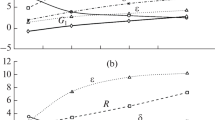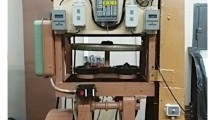Results are presented from a study of the surface deformation of strip as a function of the parameters of its bending in the rolls of a section-bending machine. The methods of correlation-regression analysis are used to analyze the experimental data that are obtained.
Similar content being viewed by others
Avoid common mistakes on your manuscript.
This article reports results from a study of the dependence of the surface deformation of strip on the main parameters of its shaping as it undergoes bending in the rolls of a section-bending machine: relative radius; relative width of the bentunder flange; angle of bending of the flange. The initial semifinished products were thin (t 0 ≤ 4 mm) hot- and cold-rolled strips of medium-carbon steel and low-alloy steel that had been laid out to a certain width (the exact width depending on the section being made).
The normal distribution of a random variable is completely defined by its mean value and variance. Thus, in order to describe the dependence of the strain e iR (the function) on one of the shaping parameters (the argument), it is necessary to show how a change in the shaping parameter changes the mean and variance of e iR . This is done through correlation-regression analysis. The problem can be stated as follows in general form. Having a given sample – especially for e iR – we find an approximate regression equation in the form e iR = ƒ(x i ). Here, x i is the shaping parameter (relative bending r/t 0, where r is the bending radius, and t 0 is the thickness of the strip; α is the angle of reverse bending of the flange of the strip; the relative width of the bent-back flange b/t 0). The type of regression curve is established on the basis of a correlation table with allowance for the physical essence of the process. Table 1 shows the data needed to construct the empirical regression line of the function e iR = ƒ(r/t 0).
The relative means of the intervals were calculated from the equation y′ = (y av – c)/i, while the mean values of e iR for the intervals were found from the formula
where c = 0.269; \( {\bar{y}_x} = {e_{iR}} \); x = r/t 0; i = 0.056; Σm x is the sum of the strain values that lie within the intervals.
It is apparent from an analysis of the empirical regression line (curve 1 in Fig. 1) that an increase in the relative bending radius to r/t 0 ≈ 4–5 is accompanied by a fairly sharp decrease in the strain followed by slowing of the reduction in e iR . A function of this nature is described well by an equation of the logarithmic type
The term a 1logx of this equation expresses the fact – which is typical of logarithmic curves – that the rate of increase in the function decreases with an increase in the argument. The coefficients a 0 and a 1 of the equation are found by the least squares method. Applying the well-known method for finding minimum values to Eq. (1), we obtain the following two normal equations:
Solving this system of equations, we find
The denominator of these relations includes the determinant of the system
the elements of which are the coefficients with the unknown quantities a 0 and a 1 on the left sides of system (2). The determinant C is obtained from the determinant of system (2) by replacing the elements of the first column by the absolute terms on the right sides of the normal equations, while the determinant B is obtained from the determinant of system (2) by replacing the elements of the second column by the absolute terms on the right sides of the normal equations. Table 2 shows the method used to calculate the coefficients.
As a result, we obtain a regression equation of the form
Replacing x in this equation by the successive values of r/t 0 for the eight intervals (see Table 1), we find the probable values y p = e iR of surface deformation for the corresponding values of the relative bending radius. We then use those probable values (Table 2) to construct the theoretical regression line (see curve 2 in Fig. 1). It can be seen from the graph that the thermal regression line agrees satisfactorily with the experimental line, which confirms the correctness of the method and the initial conditions that were used.
If deformation rate were determined solely by the relative bending radius, then all of the values of e iR would be on the regression line. The deviations of the mean values of e iR and of individual values for strain are due to the effect of other factors: in the case being discussed, those factors are obviously the angle of reverse bending and the width of the flange that is bent. The stronger the effect of these factors, the larger the deviations that are seen not only for the means of the intervals but also for the points of the entire correlation field. It is necessary to distinguish between the variation of the interval means from the theoretical values and the variation of the function values from the overall mean.
The quantity that indicates the closeness of the relationship between y and x in the nonlinear regression is the correlation ratio
where S is the quadratic mean of the corresponding estimate of the variance. Here, \( {S^2}\left( {{{\bar{y}}_x}} \right) = \left( {{{1} \left/ {n} \right.}} \right)\Sigma {m_x}\bar{y}_x^2 - \bar{y}_x^2 \) is the estimate of the variance of y x relative to the overall average \( \bar{y} \), while \( {S^2}(y) = \left( {{{1} \left/ {n} \right.}} \right)\Sigma {m_y}{\left( {y - {{\bar{y}}_x}} \right)^2} \) is the estimate of the variance of y relative to the overall average \( {\bar{y}_x} \).
The correlation ratio is a general index of the closeness of a relationship but does not account for the structure of that relationship. Thus, for nonlinear correlations we introduce the regression coefficient η′:
where \( {S^2}\left( {{y_p}} \right) = \left( {{{1} \left/ {n} \right.}} \right)\Sigma {m_x}y_p^2 - {\bar{y}^2} \) is the estimate of the variance of the calculated values of y p obtained from Eq. (5) relative to the average \( \bar{y} \).
The regression coefficient η′ = 0.79 calculated from Eq. (7) reflects the relationship between e iR and r/t 0 expressed by Eq. (5), while the correlation ratio η = 0.80 calculated from Eq. (6) indicates that the rate of surface deformation depends relatively heavily on the relative bending radius [1, 2].
The dependence of surface deformation on the angle of bending α is expressed by a correlation equation of the exponential type:
The empirical regression line (Fig. 2) was constructed from the data in Table 3, which was compiled with allowance for features of the schedules for the shaping of angles and channels: The scheme used to calculate the coefficients in Eq. (8) is similar to that used to calculate the coefficients in Eq. (1). The only difference is that y is replaced by logy in the calculated table (similar to Table 2) and in the determinants of system (4), while loga 0 is calculated using Eqs. (3). We performed calculations to obtain a correlation equation that expresses the dependence of the rate of surface deformation on the bending angle α: e iR = 0.05α0.44. We then used this equation to construct a theoretical regression line (see Fig. 2) and calculate the regression coefficient η′ = 0.50 and the correlation ratio η = 0.26. In comparing the correlation ratios \( {\upeta_{{{r} \left/ {{{t_0}}} \right.}}} = 0.80 \) and ηα = 0.26, we should point out that the highest rate of surface deformation depends on the relative bending radius more than it does on the bending angle.
We similarly examined the effect of the relative width of the bent flange b/t 0 on the value of e iR . The regression equation has the form
The scheme used to calculate the coefficients is similar to that employed above. Empirical regression curve 1 and theoretical curve 2 are shown in Fig. 3. The effect of the dimensions of the bent flanges increases with an increase in the thickness of the strip and the bending angle and a decrease in the relative bending radius. The effect of this factor on deformation decreases with an increase in flange width (at b/t 0 ≈ 15–20, see Fig. 3), as is shown by Eq. (9). The regression coefficients for (9), η′ = 0.507 and η = 0.24, show that the change in surface deformation is more influenced by the relative width of the bent flange than by the bending angle.
Conclusion. Thus, studies have shown that the rate of surface deformation of strip on the section on which bending takes place depends mainly on the relative bending radius and is considerably less dependent on the bending angle and the relative width of the product’s elements that undergo bending. As a consequence, the main focus in designing the shaping operation should be on the relative bending radius.
References
K. N. Bogoyavlenskii, V. V. Ris, and I. P. Manzhurin. “Study of the thinning of strip during its bending in the rolls of a section-bending machine,” Trudy LPI. Obrabotka Metallov Davleniem, Mashinostroenie, Leningrad (1971), No. 322, pp. 25–30.
K. N. Bogoyavlenskii, V. V. Ris, and I. P. Manzhurin. “Widening of strip during its shaping in the rolls of a sectionbending machine,” ibid., pp. 111–115.
Author information
Authors and Affiliations
Corresponding author
Additional information
Translated from Metallurg, No. 1, pp. 51–54, January, 2012.
Rights and permissions
About this article
Cite this article
Manzhurin, I.P., Sidorina, E.A. Dependence of the surface deformation of strip on the parameters of its shaping. Metallurgist 56, 37–42 (2012). https://doi.org/10.1007/s11015-012-9533-8
Received:
Published:
Issue Date:
DOI: https://doi.org/10.1007/s11015-012-9533-8







